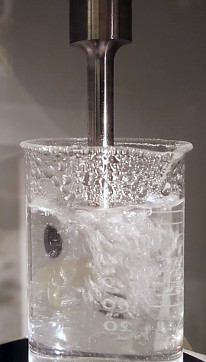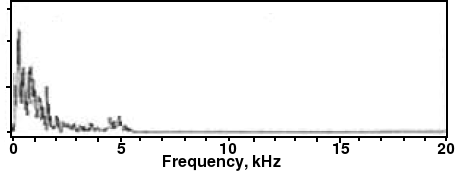 recent report claims that American diplomats in Cuba suffered headaches and hearing
loss from what was described as a sophisticated sonic weapon. It's not specified
whether that means ultrasound (sound >20kHz) or infrasound (sound <20 Hz).
recent report claims that American diplomats in Cuba suffered headaches and hearing
loss from what was described as a sophisticated sonic weapon. It's not specified
whether that means ultrasound (sound >20kHz) or infrasound (sound <20 Hz).
But it sounds impossible: how can sounds you cannot hear damage your hearing? Lots of research has been done on this topic, but very little has been found to indicate that either infrasound or ultrasound can cause hearing loss.
Infrasound
Infrasound is ubiquitous and intense: in a car you can easily be exposed to low frequency sound in excess of 100 dB, even though it barely registers on the A scale, which is weighted for human hearing. Architects go to great lengths to minimize ventilator resonances, using specially engineered duct silencers to remove low frequencies.[1] Wind farms generating infrasonic noise around 0.2 Hz produce symptoms similar to motion sickness [2], suggesting that the otoliths in the inner ear are involved.
A Russian study [3] claimed that infrasound increases the risk of neurosensory deafness and hypertensive illness caused by audible noise. However, other studies suggest that annoyance is the main effect.
The problem with infrasound is that it's nearly impossible to focus, and you'd annoy yourself even more than your opponent.
A company called HPV manufactures something called a “magnetic acoustic device” or MAD for the military. The company claims their dispersion angle is as low as two degrees, allowing sound to be projected for up to a mile, useful they say for communicating to crowds or ships. Their planar magnetic transducers appear to be ordinary flat speakers with flat diaphragms, not magnetostrictive devices, so they emit sound at audio frequencies (180 Hz–18 kHz). So it is no more a ‘sonic weapon’ than some guy with a bullhorn.
Ultrasound

Turbulence and cavitation caused by ultrasound in contact with water. The titanium probe was emitting about 50 watts at 23 kHz.
There's a lot more research on ultrasound, but even here regulatory bodies regard it as mostly harmless. The US OSHA claims that ultrasonic noise has little effect on human health unless there is direct body contact with a radiating source. The American Conference of Governmental Industrial Hygienists (ACGIH) recommended a ceiling of 105 dB for a 1/3 octave band frequency centered on 20 kHz. These limits are designed to prevent hearing loss from subharmonics, not the ultrasound itself.
The Institute of Sound and Vibration Research in the UK reviewed the literature [4] and concluded that the evidence was insufficient to show any systematic hearing loss trends from occupational exposure to ultrasonic noise.
However, a paper by Maccà et al. [5] found that exposure to ultrasound among workers induces hearing loss in the upper range of hearing 14–17 kHz of 2–5 dB per year in excess of the natural age-dependent loss. These workers worked 30–40 cm from a Branson welder, a sonic welding machine that emits intense 30 kHz ultrasonic noise.
In 1982 the World Health Organization said ultrasound induces nausea, vomiting, fatigue, headache and a sensation of fullness and pressure in the ear.[6]
Subharmonics produce the unpleasant high-pitched squeaking sound commonly associated with ultrasonic devices. Subharmonics can be caused by a variety of mechanisms including non-radial modes of oscillation or by cavitation. These can be quite loud. They account for many of the subjective feelings of discomfort, and can easily damage hearing.

Closeup of air-water interface disrupted by ultrasound
Our lab mandates earmuffs when using a probe sonicator. We have found nagging to be an effective means of inducing compliance; however, it has been suggested that the staff are using earmuffs solely to drown out our nagging.
Ultrasound is rapidly attenuated in air. A 100 kHz sound wave attenuates by about 5 dB/meter [7], practically limiting propagation to 200 meters or so, but even so an ordinary sound level meter can read over 90 dB when placed next to a 20 kHz sonicator probe vibrating in the air, even though the human ear detects nothing. If that energy comes in contact with something, it can cause heating and cellular disruption.
Animals
In the ocean, where sound energy propagates easily, sonic weapons used by animals are highly effective. Dolphins emit clicks at 100 kHz and up to 226 dB, well above the level that would cause cavitation if the sound wave were continuous[8]. They use ultrasound to detect prey, but they also use a complex waveform of intense click trains to stun and kill prey.
Ken Marten reported that these were not simple sine waves, but a complex series of pulses or buzzing sounds with a repetition rate of 200 Hz, with a terminal phase of up to 500 Hz[9]. Each pulse had a peak frequency between 1.6 and 4.64 kHz. No ultrasonic sounds were reported; however, their hydrophone could only detect up to 22 kHz. Killer whales use the same technique, making loud bangs with peak frequencies from 93 to 1422 Hz, averaging 395 Hz.[9]

Power spectrum of fish-stunning pulse from Atlantic bottlenose dolphin. The sound consists of pulses with a peak frequency of 400 Hz, duration 70 ms. (From Ref. 9)
The ocean is a noisy place; even raindrop sounds (up to 10 kHz) can propagate for a long distance. Snapping shrimp produce a readily identifiable noise from 200 Hz to 20 kHz.
Sonic weapons
In the 1970s ultrasound exposure was said to produce ultrasonic sickness, the symptoms of which included asthenia, headache, nausea, and vomiting. Intense exposure produced vertigo, loss of balance and dizziness. Acton and Hill attributed these effects to subharmonics[10].
Grezsik and Pluta [11] found similar effects, and claimed that hearing loss was related to the spectral characteristics of the ultrasound. It is conceivable that some waveforms could produce more injury to hair cells than others, but if so it is not generally known.
One obvious possibility is to use two ultrasonic tones that differ in frequency, thereby inducing an audible tone in the ear corresponding to their difference. This is called a “virtual end fire array”[12] and it's a convenient way of creating a highly focused beam of audible frequencies. However, unless the victim was underwater, it would still be subject to air attenuation, and it would be audible to the recipient.
If the two tones were close enough in frequency that their difference is below 20 Hz, you could combine the annoying power of infrasound with the focusing power of ultrasound. So you could annoy somebody from up to a hundred feet away. But we humans are an ingenious bunch, and we have devised many more efficient ways of doing that already.
1. Long M, Architectural Acoustics. Associated Press 2006, p.496.
2. Schomer PD, Erdreich J, Pamidighantam PK, Boyle JH. (2015) A theory to explain some physiological effects of the infrasonic emissions at some wind farm sites. J Acoust Soc Am. 137(3), 1356–1365.
3. Akhmetzianov IM, Zinkin VN, Petreev IV, Dragan SP. (2011) Voen Med Zh. 332(11), 44–50. [Hygienic estimation of combined influence of noise and infrasound on the organism of military men]. [Article in Russian]
4. Lawton, BW (2001). Damage to Human Hearing by Airborne Sound of Very High Frequency or Ultrasonic Frequency. Health and Safety Executive. Link.
5. Maccà I, Scapellato ML, Carrieri M, Maso S, Trevisan A, Bartolucci GB (2015). High-frequency hearing thresholds: effects of age, occupational ultrasound and noise exposure. Int Arch Occup Environ Health 88(2), 197–211.
6. World Health Organization (1982) Ultrasound. Environmental Health Criteria 22.
7. Vladisauskas A, Jakevicius L (2004). Absorption of ultrasonic waves in air. Ultragarsas 1 (50) 46–49. Link.
8. Medwin H, Clay CS (1998). Fundamentals of acoustical oceanography. Academic Press, p. 218.
9. Marten K, Herzing D, Poole M, Newman Allman K. (2001). The acoustic predation hypothesis: Linking underwater observations and recordings during odontocete predation and observing the effects of loud impulsive sounds on fish. Aquatic Mammals, 27(1), 56–66
10. Acton WI, Hill CE (1977) Hazards of industrial ultrasound. Protection 14(19), 12–17.
11. Grezsik J, Pluta E (1986) Dynamics of high frequency hearing loss of operators of industrial ultrasonic devices. Int Arch Occup Environ Health 57, 137–142.
12. Medwin H, Clay CS (1998). Fundamentals of acoustical oceanography. Academic Press, p.163.
aug 15, 2017; last edited aug 16 2017, 9:58 am
